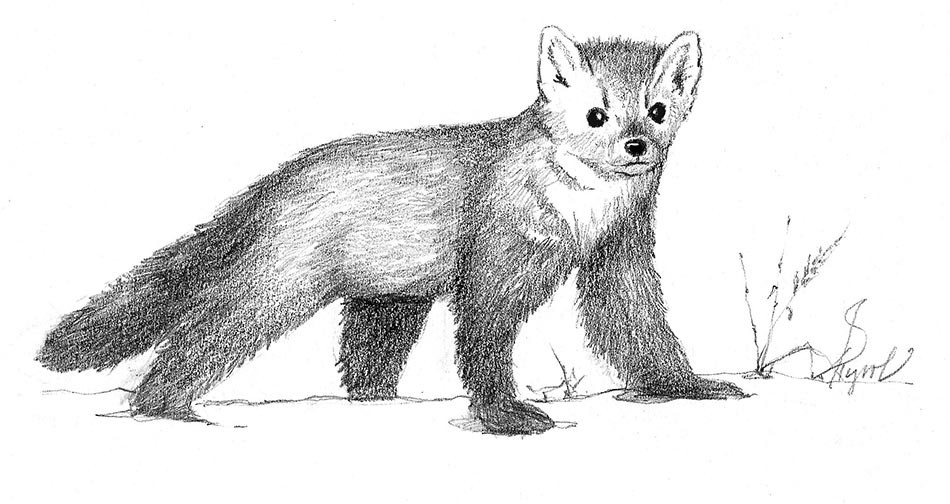
Some people keep lifelong birding lists. I’ve tried, but birds and I have never really hit it off. Too many colors, too many species, and I’m tone deaf, so birding by ear is completely beyond me. I do keep a lifelong weasel list. I can tell you exactly where I was when I saw my first white-coated ermine and how many times I’ve seen a mink. My best fisher sighting was particularly memorable: I watched in awe as it jumped from tree to tree in pursuit of a gray squirrel. I’m not a mustelid professional, a weasel guide, trapper, or even a dachshund. I’m just a naturalist completely fascinated by this family of animals. Perhaps it’s because I can relate to their body design: a long torso and short legs; or maybe it’s their unstoppable appetite, something else I personally understand. I’ve seen all the mustelids New England has to offer except for one – the elusive American marten.
The American marten (Martes americana), sometimes referred to as the pine marten, is rare in our region, though prior to colonization, this smaller-than-a-cat mammal was widely distributed and considered common across New England, at least as far south as western Massachusetts. The forces that led to it becoming a species of high concern are not unusual: habitat loss and fragmentation, as well as overtrapping. The glossy, golden-brown pelt made this animal’s fur highly desirable. By the early 1900s, it was considered extinct in Vermont and barely existed in New Hampshire. Only in the Adirondacks and remote northern Maine did populations manage to persist.
Efforts began in the twentieth century to repair the damage we’d done. Marten were reintroduced in New Hampshire in the 1950s and again in the 1970s, and populations were noticeably bolstered by the 1990s. The comeback continued, and in 2016, marten was removed from the state Threatened and Endangered Species List.
Things didn’t go so well in Vermont; at first, anyway. From 1989 to 1991, Vermont’s Fish and Wildlife Department and the US Fish and Wildlife Service reintroduced 115 American martens into southern Vermont’s Green Mountain National Forest. The vast majority of these pioneer martens came from Maine, and the rest were from the Adirondacks. Hopes ran high, but by the mid-1990s, the reintroduction was considered a failure. No evidence could be found that any of the martens had survived. One theory as to what happened points the finger at another member of the mustelid family: the fisher. A larger cousin to the marten, the fisher had been successfully reintroduced to Vermont in 1959 as a way to control an over-abundance of porcupine. Fishers compete with and hunt marten. Perhaps the failure of the marten reintroduction had something to do with the success of the fisher recovery – a reminder that everything in nature is connected.
Yet it’s also a truism that wildness often finds a way to persist. For 15 years, marten went undetected in Vermont. But then several were accidentally caught in fisher traps in the southern Greens, which spurred a whole new search for them. A small but stable population was discovered in southern Vermont, and another population was discovered in the northern part of the state. These two distinct pockets of marten raised some intriguing questions: Were these the offspring of the original reintroduced martens? Are the populations related? Or did these new arrivals come from another place?
To answer these questions, Dr. C. William Kilpatrick and a team of scientists at the University of Vermont’s biology department looked into the genetic makeup of the two populations. By examining the DNA of both populations, and comparing them to each other and the other surrounding populations from the Adirondacks, northern Maine, and northern New Hampshire, the researchers have been able to shed light on this tangled tale.
According to Kilpatrick, the story of the American marten in Vermont is complicated. The data suggest that the newly discovered southern population does have genetic lineage with the marten that were reintroduced back in the 1990s. The northern population has markers that tie it to populations in northern New Hampshire, with a dash of genes from the southern Vermont population. This suggests connectivity between the two populations and invites Vermonters to consider how to continue protecting land to increase this landscape connection. “The marten is a window on what is possible,” says Dr. Kilpatrick.
The last thing Dr. Kilpatrick shared was, to me, the most intriguing: there is some suggestion that the southern Vermont population has genes from a relic population. Could it be that martens had actually managed to survive in the Green Mountain National Forest, tucked quietly out of our view, ever since pre-colonial days?
I like to think this is possible. I like to imagine myself, out in the deep soft snow of the Green Mountain National Forest, following the bounding slink of a marten. I see myself reaching my hand into the track, touching impressions of the five teardrop-shaped toes. It would be like touching hope.


Discussion *